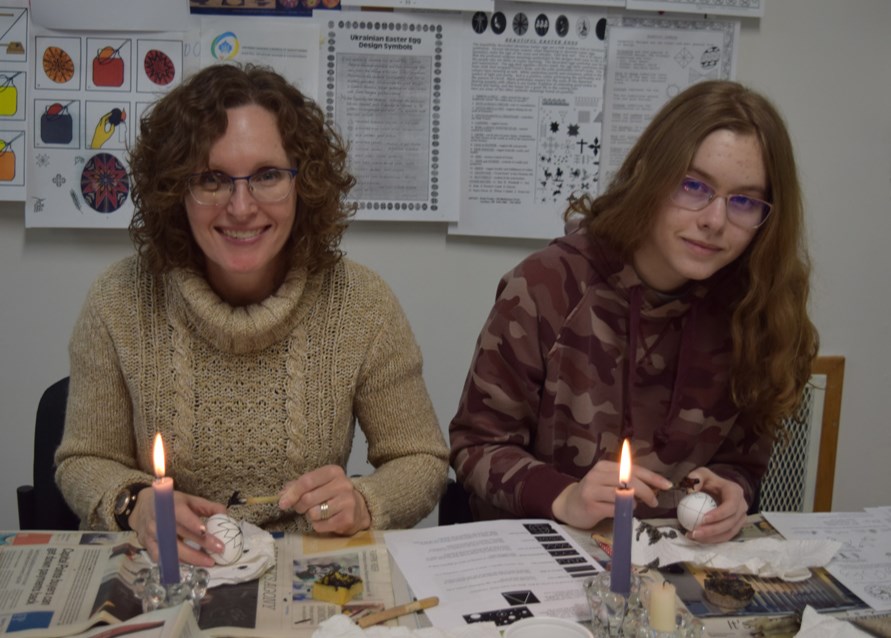CANORA - A number of Canora and area residents showed that interest in the Pysanka (Ukrainian Easter egg decorating) tradition is definitely alive and well.
Audrey Hrycak led the participants in the Pysanka Writing Workshop at the Ukrainian Heritage Museum in Canora on March 25 through the steps in this popular tradition.
“I got interested in Pysanka when I was in a group while attending university,” said Hrycak. “I think it’s important to keep the tradition alive.
“Pysanka means ‘to write.’ So what we’re doing here is telling a story by decorating the eggs.”
Hrycak teaches the Batik method, “where each colour is added and then covered with wax to preserve the colour, and then a new colour is added.”
Among those getting involved in Pysanka were Naomi Kapitoler and her daughter Aeowyn, who succinctly observed, “This is such a cool thing to learn.”
Naomi, who remembered trying Ukrainian Easter Egg decorating as a youngster, had wanted to get back into it with Aeowyn, “but doing it on our own was too much. Then I saw the ad for this opportunity. It’s wonderful that they offer it here.”
According to information shared with participants by Hrycak, there are a variety of tales and legends of how it came to pass that the Ukrainian people adapted the art of making Pysanky as part of their beloved cultural traditions.
“Just when the richly ornamented egg made its first appearance is difficult to establish,” stated the information.
“There was the tale of Mother Mary, whose tears fell on a basket of plain eggs – all at the time Jesus was crucified. But when someone looked at the basket, they say that those eggs were plain no longer, but instead they were marvelously designed and of all colours of the rainbow – truly a beautiful miracle. When Mary stood up, the eggs fell out of the basket and rolled in all directions of the compass- thus symbolizing the birth of Christianity all over the world.
“Then there was the Legend of the Easter Egg. One day a poor peddler was going to the store to sell a basket of eggs. He became a part of a crowd and realized that the crowd was taunting a man carrying a heavy cross on which he was about to be crucified. The peddler ran to help the man, leaving his basket of eggs by the roadside. When he returned for his basket, the eggs had been changed into eggs covered with beautiful designs and colours. Of course, the man with the cross was Jesus Christ. Ukrainian legend believes the peddler was Simon.
“As Christianity spread into many areas which years ago had been pagan, the tales of the beautiful eggs fit in with the love of colours and artistic creations, as well as religious symbolism of the peoples who were accepting Christianity around 988 A.D. The egg itself had previously been a symbol of birth, spring and fertility. Now it became a symbol associated with the ‘rebirth’ of the world, in the sense that acceptance of Christianity was a spiritual rebirth. Therefore, it became a reminder of many things to the early Ukrainian people who loved beauty and colours, and happy traditions.
“Pysanka plays an important part in traditional Ukrainian Easter customs. They are placed in the Easter basket with other foods that are blessed on Easter Sunday. Some Pysanka are afterwards exchanged as tokens of good will.”
Participants in the Pysanka Writing Workshop in Canora learned that designs on Pysanka may be classified into three categories: geometric, plant and animal.
Geometric motifs are the oldest and most general forms of ornamentation.
Dots are frequently used, and may be large or small. At times, they are scattered over the field to suggest stars.
The triangle may symbolize any trio, such as: the Holy Trinity; earth, heaven and hell; air, fire and water.
The cross is one of the most widely used motifs. It was used before the advent of Christianity, but it has since assumed only Christian significance.
Plant ornamentation is not as ancient as geometric. Either a whole plant or parts of it are drawn. The rose is an example. This motif gives the appearance of a star or even a system of stars, one upon the other. It is not the purpose of the motif to represent a plant in its actual detail.
Another plant example is the tree, which is found in many combinations. It is sometimes placed in the form of a cross. It symbolizes eternal youth and health.
The animal motif dates back to the Stone Age. The most common figures are: reindeer, horses, fish, butterflies, birds or hens. Sometimes only parts of animals are drawn, such as ram’s horns, hen’s feet, and goose or duck feet. The hen as the actual fruition of the egg symbolizes fertility and fulfillment of wishes. The reindeer symbolizes wealth and prosperity.
The information provided concluded with the following message of encouragement: “For writing Pysanky, patience is the essence. However, all the effort and care is rewarded when the final product is viewed. The pride of great accomplishment can only be appreciated by those who have experienced it.”




